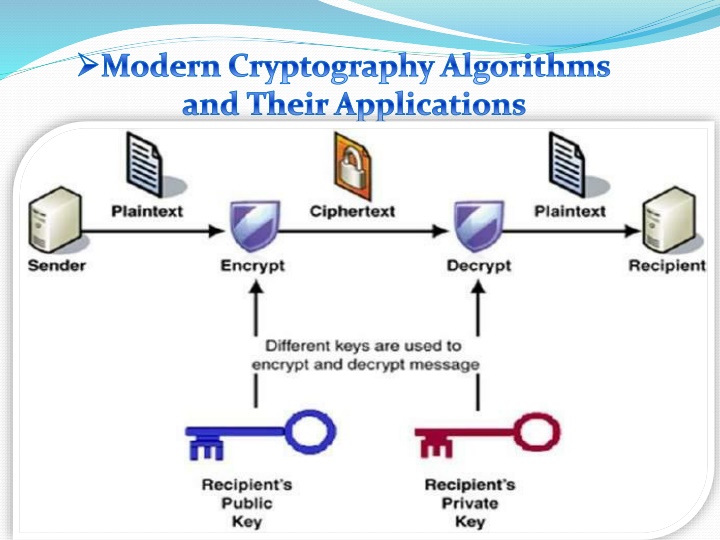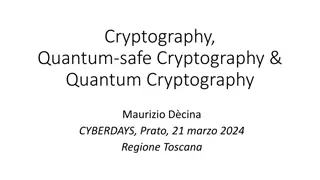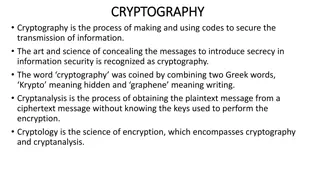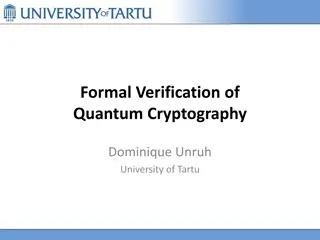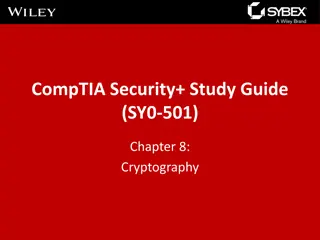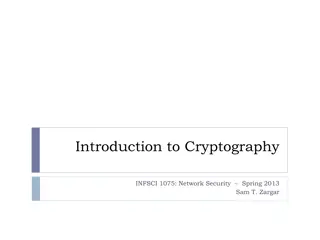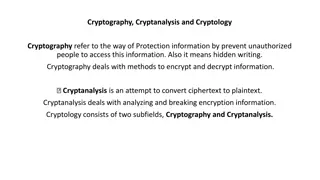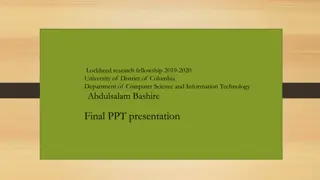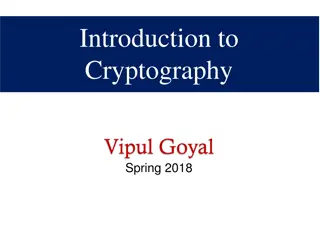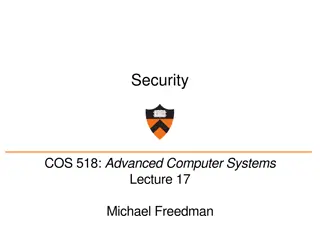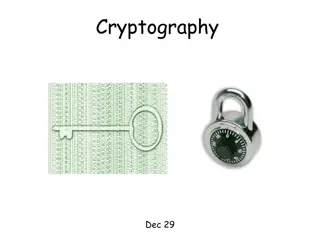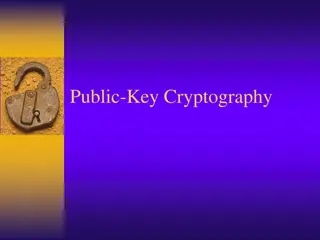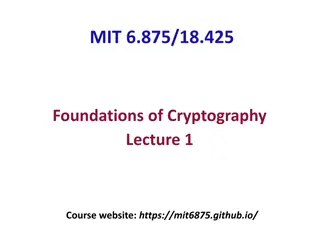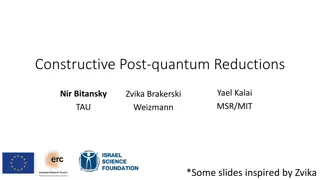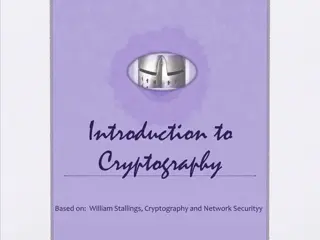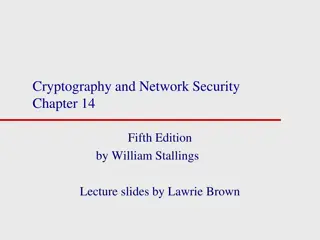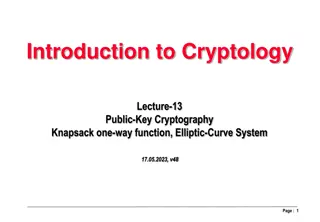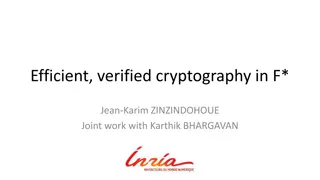Modern Cryptography: Algorithms and Their Applications
Cryptography involves securing and transmitting information through various techniques like encryption, decryption, and cipher text. It encompasses different security types, including communication security and transmission security. The history of cryptography systems is rich, spanning from letter substitutions to sophisticated rotor machines. Encryption structures are classified into block ciphers and stream ciphers, each with its characteristics and uses. Symmetric-key cryptography is a key aspect of cryptographic systems, offering secure communication channels through shared secret keys.
Download Presentation

Please find below an Image/Link to download the presentation.
The content on the website is provided AS IS for your information and personal use only. It may not be sold, licensed, or shared on other websites without obtaining consent from the author.If you encounter any issues during the download, it is possible that the publisher has removed the file from their server.
You are allowed to download the files provided on this website for personal or commercial use, subject to the condition that they are used lawfully. All files are the property of their respective owners.
The content on the website is provided AS IS for your information and personal use only. It may not be sold, licensed, or shared on other websites without obtaining consent from the author.
E N D
Presentation Transcript
Modern Cryptography Algorithms and Their Applications
Cryptography Items Plain Text : The original message (text, image ,video, etc. Cipher Key : Encryption works by running the data (represented as numbers) encryption formula (called a key). Both the sender and the receiver know this key Cipher text: Combination of plain text and the secret key Decryption: Recovering information from cipher text through a special
Security types 1- Communication Security: In this type the 3rdparty can receive information cannot know information orchange it but the 2- Transmission Security: In this type the 3rd party don t know there is a communication or know but hasn't ability to listen reception
Cryptography Systems (History) 1. Substitutions: the Letters of plain text are replaced by other symbols , numbers, etc. 2. Transposition: rearranging the order of the elements of the plaintextaccording toa proposed algorithm. 3. Polyalphabetic Ciphers :polyalphabetic cipher is a cipher where different substitution alphabets are used for various parts of the plaintext. 4. Running Key Ciphers: polyalphabetic substitution, where the secret key is repeated along the length of plaintext/ciphertext
5- Roter Machines: Used a series of rotating cylinders to implement a polyalphabetic substitution cipher of period K, with 3 cylinders, K = 263= 17,576, with 5 cylinders, K = 265 = 12 ? 106and so on. And other types.
Structures Classificationof Encryption 1- Block Cipher: in this type asymmetric key is used, it encrypt n-bit block of plain text which controlled by a secret key , as the block size increase the security of encryption increase too but the complexity of decipher algorithms will also increase
1- Stream Cipher: in this type the plain text is processed bit by bit as a stream, in most stream cipher a Pseudo Random Number Generator (PRNG) is used togenerate the secret key.
Classification according to the Keys 1- Symmetric-key cryptography Symmetric-key cryptography refers to encryption methods in which both the sender and receiver share the same key (or, less commonly, in which their keys are different, but related in an easilycomputableway).
2- Public-keycryptography cryptography in which two different but mathematically related keys are used a public key and a private key . A public key system is so constructed that calculation of one key (the 'private key') is computationally infeasible from the other (the 'public key'), even though they are necessarily related. Since two keys are used in this method then it is called asymmetricencryption.
Percentageof Data Classification 1- Full Encryption: This type offers a high level of security and effectively prevents unauthorized access. Images as a binary large objects or pixels are encrypted in theirentirety. 1- Partial Encryption: In this type, a part of data is encrypted therefor it is also called selective encryption.
Key Size The size of the key space is the number of encryption/decryption key pairs that are available in the cryptosystem. If ??to denote a key and ? to represent a finite set of possible keys, which is also called the key space and can be expressed as ? = {?1+ ?2+ ?3 + }
Attacks Classification 1- Cipher text only attack 2- Known plain text attack 3-Chosen plain text attack 4- Chosen cipher text attack 5- Brute Force Attack
Chaos System The word chaos has been derived from the Greek, which refers to unpredictability which is a mathematically physic which was developed by Edward Lorenz There exist two approaches of designing chaos-based cryptography 1- analog Which are secure communication schemes designed for noisy channels based on the technique of chaos synchronization 2-Digital Are designed where one or more chaotic maps are implemented in finite commuting precision to encrypt the plain- messages in a number of ways
Linear Chaos System A linear process is one in which, if a change in any variable at some initial time produces a change in the same or some other variable at some later time. Non LinearChaos System All systems that are not linear are called Nonlinear systems. In these systems, the change in a variable at an initial time can lead to a change in the same or a different variable at a later time, that is not proportional to the change at the initial time.
Properties Chaos System 1- Deterministic Which means that the chaotic systems have some mathematical equations ruling their behavior 2- Sensitivity These system is sensitive to initial conditions and parameters which make them change quickly 3- topological transitivity Is the tendency of the system to quickly scramble up small portions of the state space into intricate a network of filaments.
Some Examplesof Chaos System 1- Lorenz System Deterministic Non periodic Flow which has the following dynamic equations ?? ??= ? ? ? , ?? ??= ?? ?? ?, ?? ??= ?? ??
2- Rossler System Otto E. Rossler tried to enhance Lorenz attractor and design this model which consists only one non- linear term (??) and the non- linear ordinary differential equations ?? ??= ? ? , ?? ??= ? + ??, ?? ??= ? + ?? ??
3- Liu System The master system is described by the Liu dynamics equations ?? ??= ? ? ? , ?? ??= ?? ?z, ?? ??= ?? + ??2
4- Chen System Chen system can be applied to designing a cryptosystem with higher security. Chen dynamical system is described by the following system of differential equations ?? ??= ? ? ? , ?? ??= ? ? ? ?? + ??, ?? ??= ?? ??
Encryption based Chaotic System 1- Confusion This process refers to substitutions which intend to make the relation ship between the key and the cipher text as complex as possible 1- Diffusion This process refers to rearranging or spreading out the bit of the message , to obtain new values which can be obtained again by the receiver
Examplesof Image Encryption 1- Baboon Cryptography Encrypted Image Decrypted Image Original Image
2- Girl Cryptography Encrypted Image Decrypted Image Original Image
2- Flower Cryptography Decrypted Image Original Image Encrypted Image
References 1- Eng. Ibrahim Fathy El-Ashry Digital University Faculty of Electronic Engineering Dept. of Electronics and Electrical Communications Engineering, 18, No. 3, pp. 1-14, 2009. 2- Afnan Sameer Yaseen Al-Ali Eng. C Chaos Encryption Encryptionof of Wavelet Wavelet- -based basedImages Images, , University of Basrah. 2005 3- Yaobin Mao1 and Guanrong Chen2 Chaos Nanjing University of Science and Technology maoyaobin@163.com 2 City University of Hong Kong gchen@ee.cityu.edu.hk 4- Sunil Pandey, Praveen Kaushik, Dr. S.C. Shrivastava Rossler Dynamical DynamicalMachine MachineFor ForCryptography CryptographyApplications 5 5- - Pianhui Pianhui awu awu research research on on digital digital image image Watermarking Chaos Chaos University of Derby , May 2003. 6- Edward N. Lorenz Deterministic Deterministic Non Non- -Periodic 7- Gonzalo Alvarez1 and Shujun Li2 Some Requirements Requirements for for Chaos Chaos- -Based Based Cryptosystems Cryptosystems International Journal of Bifurcation and Chaos, vol. 16, no. 8, pp. 2129-2151, 2006. Digital Image Image Encryption Encryption , Menofia haos Encryption Encryption Methods Methods for for Partial Partial Chaos- -Based Image Encryption Based Image Encryption 1 Rossler Nonlinear Nonlinear Applications Watermarking based based on on Hyper Hyper PeriodicFlow Some Basic Flow 7jenuary ,1963. Basic Cryptographic Cryptographic
